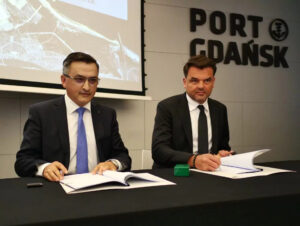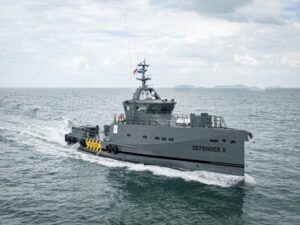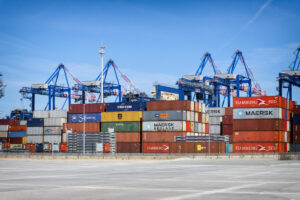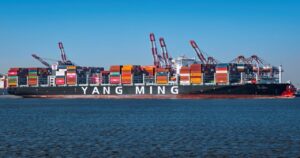Digital twins can help ports cut emissions, improve safety processes and allow maritime stakeholders to effectively share data. Port authorities, terminal operators and logistics specialists are already beginning to see the value of implementing a digital twin.
What is a digital twin?
A digital twin is a digital representation, or ‘twin’, of a physical object or system can take whole components of a physical entity – such as a port complex or terminal – and virtually map that body into a 3D interface or provide organised datasets for the user.
Unlocking the full potential of digital twin technology involves the use of multiple data sources across a port.
The digital twin takes in data ranging anywhere from Internet of Things (IoT) sources including AIS information and cargo-hold from carriers; to performance statistics and maintenance status of port tractors and carriers – and even stevedore mobile phones to send real-time information to port operatives to provide actionable insights.
A digital twin can provide a multitude of benefits ranging from operational maintenance to predictive analysis for the twin operator.
Some may confuse a digital twin with simulation technologies, however there are key differences between the two. A digital twin can utilise the regular intake of real-time data from a port complex of cargo movement or trucking congestion, compared to traditional simulations with may not integrate real-time information, for example – increasing accuracy.
How big is the digital twin market?
The digital twin market is anticipated to reach a staggering $86.09 billion by 2028, according to a study from Grand View Research.
But digital twins are still in early stages of use in smart ports and the maritime industry.

In this article Port Technology International takes a look at some of the most prominent use cases of digital twin usage in the maritime sector and some of the ways digital twin technologies can help ports.
Mirroring
One of the key capabilities of digital twin technology and an important way it can help ports is the monitoring of all operations in a port complex.
In an exclusive paper for Port Technology, Jose Antonio Gonzalez Florido and Alejandro Cadenas González of Telefónica Global wrote about how a whole port complex itself and be modelled and monitored through real-time information and incoming data that an IoT system can capture.
An entire port can potentially be modelled and accordingly a digital twin of the whole port can be very useful to predict water flows, issues with the cargo processed, or even problems with the coming ships, Florido and González wrote.
“Digital twins…improve mooring and casting off, remote controlled cranes, connected vessels, asset tracking, these are only a few examples that can help the customer to minimise operational costs, improve customer satisfaction, optimise revenues, and even generate new revenue streams.”
Maintenance
Belfast Harbour has seen significant benefits in rolling out digital twin technology for maintenance on its 2,000-acre site.
Working with solutions provider 3DEO, the site has a number of IoT sensors installed which can accurately measure, map, and give data sources for assets including cranes, yard equipment, and terminal facilities to provide port operatives with advanced knowledge of upcoming maintenance needs.

These sensors can accurately measure the assets and send real-time reports on crane cable health, for example, to the port’s maintenance team – meaning engineers can action faults before they occur.
Additionally, digital twins allow engineers a safer way to monitor equipment as they no longer have to manually assess health of equipment.
Monitoring
Digital twins – and digitalisation more widely – will be pivotal in improving efficiencies and environmental emissions monitoring as maritime stakeholders look to reduce their carbon footprint.
Through visualised digital twin platforms, a terminal operator, for example, can monitor end-to-end cargo tracking and fleet management services, as well as supervise the workforce in the field.
The result is more accurate and pinpointed loading and unloading times, for example, creating faster truck and ship turnaround times.
Improved accuracy with real-time information could also lead to a potential reductions in failures in container movements by cranes and operatives – reducing energy usage and a port’s overall carbon footprint.
A terminal – such as Abu Dhabi Terminals using Microsoft’s Azure services – can use data to digitally map a crane’s box moves-per-hour, gaining information to reduce wasted movement and energy emitted by handling equipment.
Energy efficient solutions with sensors that control power, gas and water consumption are also gaining more relevance in order to guarantee the sustainability of the port.
By first measuring the total time a straddle carrier is in use, for example, a port can implement smart systems, automation and remote control of equipment to achieve optimised equipment levels and vehicle management, reduced idle time, fewer fleet hours, and pooled equipment management.
Predictive analysis
Moving forward, a port can be provided with significant foresight and planning knowledge through predictive analysis.
The AIDrivers digital twin can be utilised to simulate future scenarios to enable ports to re-evaluate their data, efficiency and resource requirements.
Ports can recreate virtual scenarios with different environmental configurations, different fleets and different levels of autonomy.
The use of AIDrivers’ digital twin is applicable when there is a need to integrate autonomous technologies, for example, in a terminal without disrupting the operations.
“The digital twin creates awareness of autonomously operated vehicles, showcases different sophisticated use cases which is difficult or not possible to reconstruct in the real-world environment due to the risk,” explained AIDrivers Founder, Dr Rafiq Swash.
Dr Swash said the use of digital twin will become a real novel technology for ports who want to reconfigure their operations without the initial need to invest on new trucks or equipment.
“For our solutions, it doesn’t matter if it drives the real truck or the virtual truck in the truly reflected environment and scale.”








